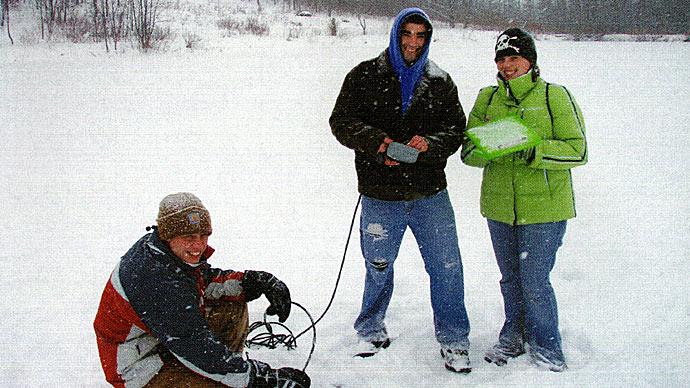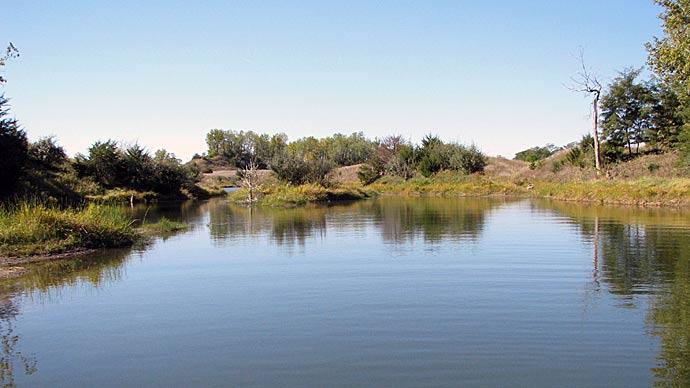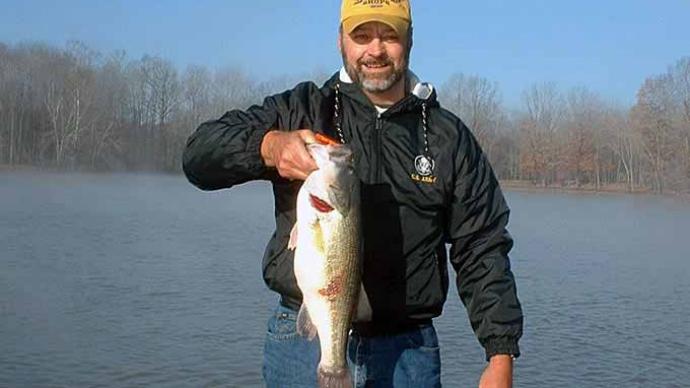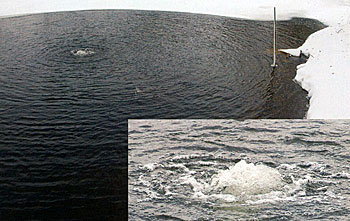
Tree leaves have fallen weeks ago. Many were laying on your pond's surface. Now a typical northern, cold, and snowy winter has begun. Ice has been on the pond for about ten days. After a couple blustery, snowy days, a layer of fluffy white stuff is covering a now solid-surface pond. More snow is predicted this week. Air temperatures are regularly less than 10°F pushing toward 0°F. On these cold nights, the ice is getting thicker each day.
Beneath the snow and ice cover it is pitch black. With weeks or even months of 0l' Man Winter ahead of us, can your pond breathe? Will the vault of stored dissolved oxygen last until the spring thaw?
Shallow lakes are more likely to experience winterkill than ponds 12 feet deep or deeper. In Midwestern Snow Belt states, at least 25% of the pond should be 10 feet or deeper. Ponds in more northern states should have 25% of the depth be 14 feet or deeper. Northern ponds that have extended snow cover and are less than 10 feet deep are good candidates for winterkill. Be prepared. The guy down the road lost all his lunker bass and big bluegill last year during winter. Smack dab dead—all of them. You sure don't want that to happen in your favorite backyard fishing hole. Should you worry? What is a pondmeister to do? Will the system that you put in for this winter also work during the summer?
The oxygen, also known as dissolved oxygen (DO), in the water should be thought of as a savings account in the bank. Fish waste products, decaying dead plant materials and all the living organisms in the pond are taking money out (Dissolved Oxygen or DO) on a minute-by-minute basis. In addition, hydrogen sulfide, methane and ammonia are slowly accumulating near the sediments where the fastest decay and bad gas production primarily occurs. If the ice is clear and not snow covered, sunlight filtering through the ice will allow microscopic phytoplankton and some of the cold water plants in shallow water to produce valuable oxygen, increasing the DO savings account whenever they receive sufficient sunlight. However, they also use oxygen during cloudy days and at night.
A storm rolls through the area, and drops even more snow on the ice. Now what? If the ice is thick, and still clear, removing the snow will allow sunlight to reach the water under the ice. It is considered best for optimum light penetration and amount of effort used to remove snow in alternating strips compared to clearing snow from one large area. Three inches of clear ice and five inches of snow can reduce total light transmission to 1%, which is not enough light for oxygen production by plants. Cloudy, milky colored ice also significantly reduces light transmission. In an extreme case, dissolved oxygen has been measured to decrease very rapidly under snow and ice cover in a Michigan lake (12.3 ppm to 2.4 ppm in 2 days [5ppm/day]). Dissolved oxygen loss is not normally this rapid when fresh snow blankets the ice cover. Some deep lakes can withstand weeks to several months of snow covered ice conditions and still have adequate DO for fish survival. Remember deeper water is better, there is more DO banked.
The primary cause of DO loss in winter is not due to fish using oxygen but due to the amount of microbial activity and decomposition of organic particulates in the water column and on top of organic sediments. The more organically enriched and shallower the water body, the more rapid the loss of DO will be in the dark conditions under snow covered ice. Remember all those tree leaves lying on the pond's surface this fall? Additional bacteria on all those sunken leaves are now consuming oxygen as the leaves slowly decay.
WHAT TO DO?
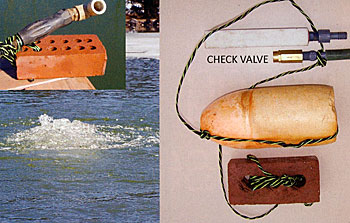
Keeping a portion of the pond free of ice will allow sunlight in; oxygen to be absorbed and harmful dissolved gasses will escape into the air. But, what is the best way to create some open water in winter?
Diffused aeration is the best and easiest way.
Pushing air into the pond creates upwelling water filled with bubbles that diffuse some oxygen into the water. Moving water melts ice and refreezes at a much lower temperature than calm water. On a sunny winter day, without a thick snow layer on the pond, oxygen-producing plants and phytoplankton can increase the oxygen savings account by several parts per million. The standard goal for the amount of open water during winter is about 10% of the surface area. A little open water is much better than 100% ice and snow cover.
HOW TO AERATE A WINTER POND
For the purposes of this article, we're assuming that the pond in question already has some form of aeration set up that has been placed in deep water and designed to mix and turn over the entire water column or most of it during the open water season. This complete mixing of the pond during winter ice cover will cause water temperatures to be below the normal pond temperature of 39°F. This is due to moving warmer water of 39°F in the water column to the open water surface where it is further chilled by exposure to very cold air temperatures. Full pond aeration during winter can lower the water temperature of the entire pond to as low as 33°F and possibly to 32°F. This cooler-than-normal water can be stressful to warm water fish that are naturally adapted to survive winter in 39°F water, which is the normal bottom to near surface temperature in all ice-covered ponds and lakes. To minimize cooler-than-normal temperatures in the water we suggest the following options as methods to aerate in winter in order to minimize the risk of winterkill. Water at 39°F is the heaviest that water weighs, so it sinks. Cooler water is less dense, so is warmer water.
OPTION 1
Turn off all diffusers and move one of the diffuses into shallow water 3 to 4 feet deep. As you do this, be sure to follow manufacturer's recommendations about shutting down the air compressor to minimize risk of back pressure on your unit. Moving a diffuser into a shallow area tends to mix and circulate water that is less than five feet deep while keeping an area of open water near the shore. The warm water refuge 39-41°F will be deeper than five feet.
OPTION 2
Turn off all deep diffusers and replace one diffuser with an air stone or allow air to flow directly out of the open hose (Figure 1). Suspend the end of the airline 2 feet from the surface with a float and weight located about 30 to 50 feet from shore. This option creates fairly large bubbles and a vigorous surface water disturbance to keep an area of water open for sunlight penetration.
OPTION 3

Turn off all deep diffusers and replace one membrane style diffuser assembled as in Figure 2, or this style diffuser in the pond from the beginning and just turn it on for winter. Adjust this style of diffuser so that when in use the diffuser head sits one third the maximum depth of the pond. When air is moving through the diffuser it floats toward the surface and releases tiny air bubbles at the desired depth. When air flow stops, the diffuser (attached by flexible hose to its base) sinks to the bottom and does not interfere with fishing in open water. This style of diffuser will mix and aerate primarily the surface layer above whatever depth it is located in the pond. The tiny air bubbles will put more DO into the water and spread this water further under the ice than Options 1 and 2.
Options 2 and 3 create the maximum open water area away from shore while only mixing the surface layer of water. This secures a 39°F maximum depth deep-water zone away from the diffuser where fish can find an important warm water refuge that has had minimal disruption by water circulation. Whenever the deep water refuge develops low DO conditions, fish instinctively move upward to seek higher DO that will be found in the surface aerated water. We and several fish farms have found that aerating with options 2 or 3 results in minimal winterkill and healthier fish during severe northern winters compared to deep water, full pond aeration.
Some pond owners that have ponds smaller than one acre have had success with intermittent aeration in ponds during milder winters and the subsequent reduced chances of winterkill. The aerator is operated several hours a day to create open water and distribute some DO. Then the aerator is turned off, allowing open water to refreeze, and the clear ice allows sunlight to penetrate into the pond. Sometimes the air line will freeze, and not allow air to the diffuser the next time it is turned on. Adding approximately a cup of isopropyl alcohol to the airline is the usual method of melting the ice inside the airline. Isopropyl alcohol has no effect on the pond's biology.
WINTER AERATION SAFETY
We suggest diffusers be located so they keep the open water close enough to the shore so that if someone, or an animal, falls into open water they can get out without having to climb onto slippery ice with soaked and heavy winter clothes in frigid water. Do not get closer than 50 feet to the open water that receives winter aeration. When walking on a frozen pond, always carry ice safety items such as an ice spud to check ice thickness and ice fishing safety spikes around your neck. Don't go out alone on pond ice without someone knowing where you are and when you are expected to return. Preventing winterkill is important, but safety is much more important.
Scott Schillig is owner of Hoosier Pond Pros in northern Indiana. Bill Cody is a pond expert with a primary focus as a microbiologist from northwestern Ohio. Both of these guys are frequent contributors of the Pond Boss forum and can be reached there.
Reprinted with permission from Pond Boss Magazine

